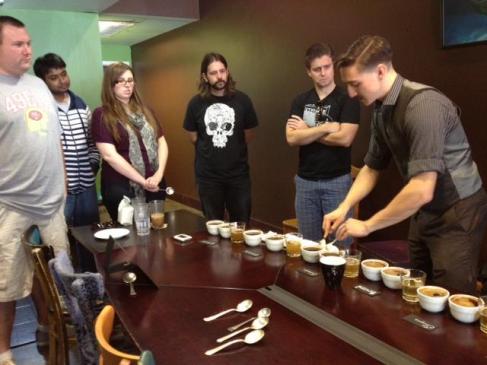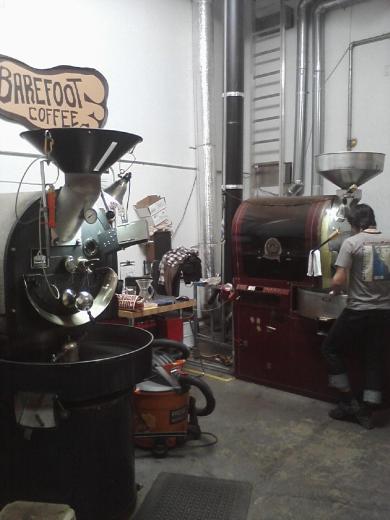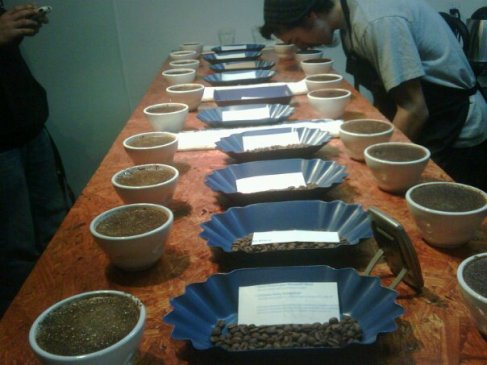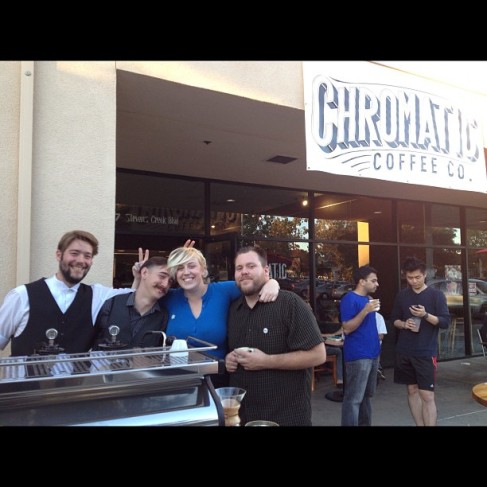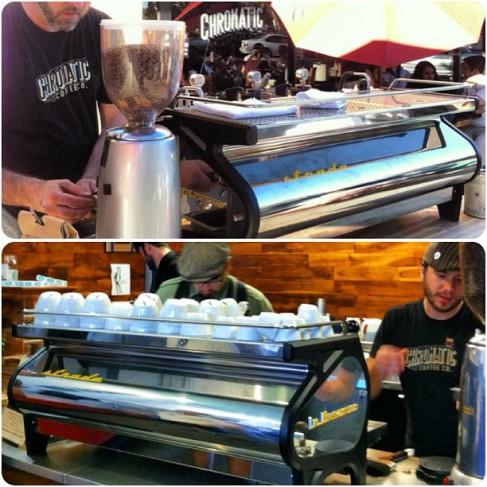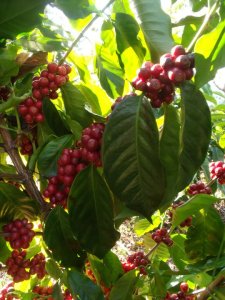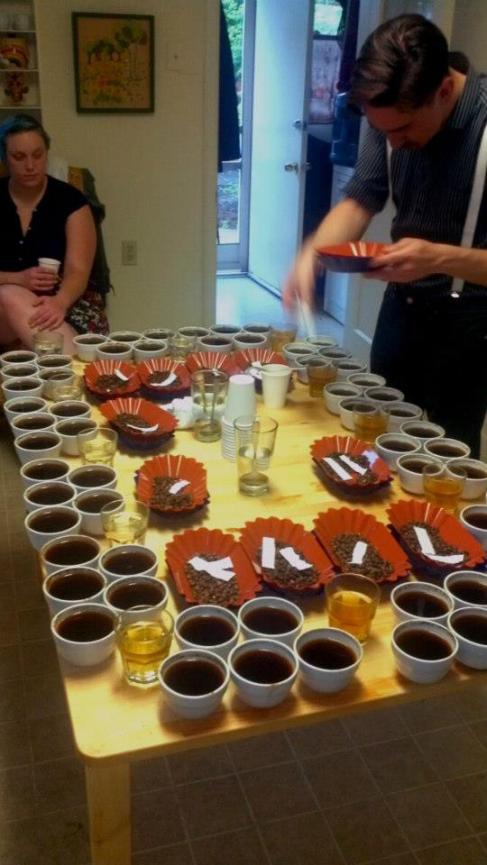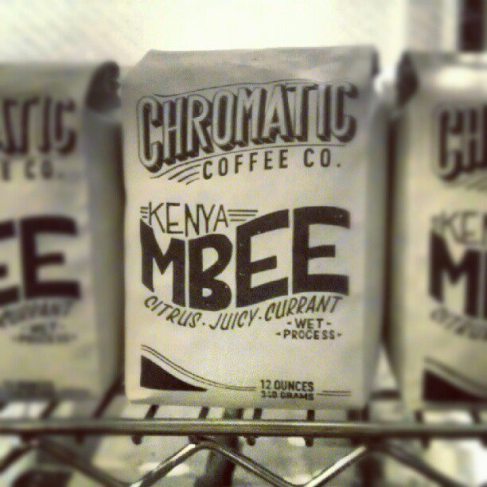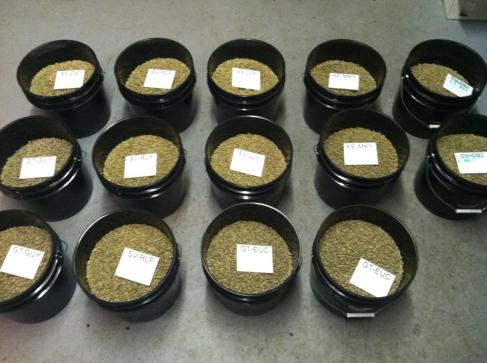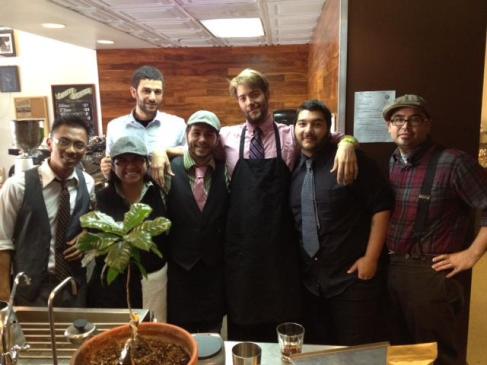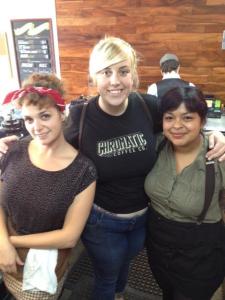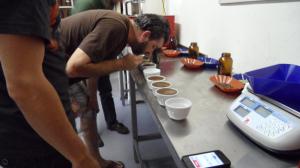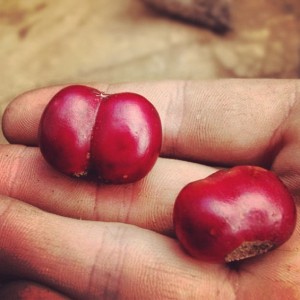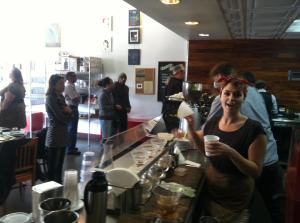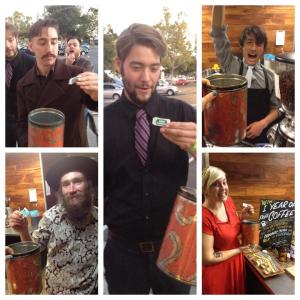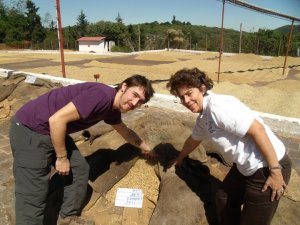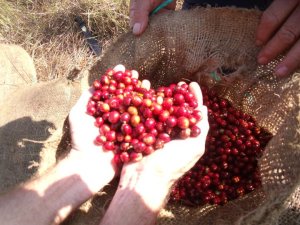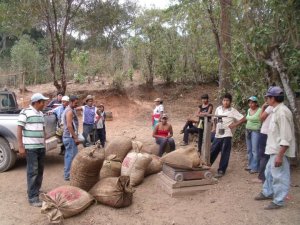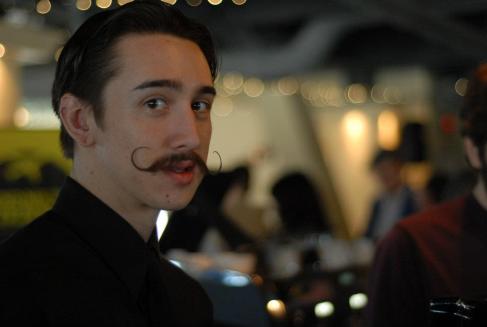Those of you who familiar with Barefoot Coffee Roasters from San Jose, CA and had a chance to visit it roastery and get the first hand experience with the roasting process, perhaps met Mr. Hiver van Geenhoven who roasted coffee for Barefoot from 2009 to 2012. At Barefoot he was involved in cupping, sorting, roasting, testing, brewing, production and more. Hiver loves coffee and pretty much dedicated in what he does. He studied Political Science at the California State University from 2005 to 2006 and as he put in his own words “this place was less than ideal”. In 2012 Hiver left Barefoot and became a co-founder of The Chromatic Coffee Company.
Chromatic Coffee Company is located in the California Bay Area. The roasting facility is in downtown San Jose and the cafe is located in the city of Santa Clara. The Chromatic cafe specializes in espresso and pour over coffee, including single cup Hario V60, and Chemex. On the espresso bar multiple single origins are offered as well as a seasonal blend. Most the equipment has been modified of created to suit the specific needs in order to craft a consistently great cup of coffee. La Marzocco Stradas reside both in the cafe and the lab, where constant testing of the product takes place. The cafe uses an advanced reverse osmosis system that recombines filtered water to achieve consistent quality water that feeds to all the machinery. Chromatic Coffee Company does not have website yet but if you have facebook account you can “like” and find more about this new venture by clicking here. Chromatic Coffee Company located at 5237 Stevens Creek Blvd. Santa Clara CA 95051
Mikhail Sebastian: At what stage did you realize that you will end up in the coffee business?
Hiver van Geenhoven: I was fascinated with the abundance of options that the coffee industry has to offer. I first was interested in coffee after doing a college presentation on the nutritional properties of coffee beyond the effects of caffeine. Coffee as a whole maintained my interest unlike anything else I had ever encountered. It has politics, economy, international trade and business, social issues, art, creativity, science, machinery, electronics, agronomy and agriculture, a whole lot of opinions, just to name some. At that point I decided to pursue a career in coffee. The only thing to find out was what and how.
Mikhail Sebastian: What attracts you to be prominent in the rapidly growing specialty coffee industry?
Hiver van Geenhoven: This industry is geared by some of the most varied and driven individuals I have ever met. One has to be aware of what the other is doing and stay ahead of the game. There are multiple ways of doing that, from quality control to marketing, but as I feel, everybody’s heart is in the right place and I think it drives the desire to achieve excellence out of all of us involved in the specialty coffee industry. The bay area is a growing center of fine coffees, and I for one, want to see it expand beyond San Francisco.
Mikhail Sebastian: You were part of the team of Barefoot Coffee Roasters for some time. What made you separate yourself from Barefoot and go on your own? Was it a hard decision to make?
Hiver van Geenhoven: The decision was a complicated one. I have been fortunate to have experiences in origin trips that have taught me a lot about processing and specific qualities. This has influenced my roasting techniques and philosophies to control my machinery in a way that I find bring forth desirable cup qualities as well as develop some of the best characteristics unique coffees have to offer. There comes a time one wants to create something uniquely theirs, and I have some amazing friends whom I am proud to be able to say that Chromatic Coffee Co. is of our own creation, the fruit of our own labor.
Mikhail Sebastian: You are co-founder of The Chromatic Coffee Co. Whose idea was it first in setting up this new coffee shop, and how did you come up with it?
Hiver van Geenhoven: James Warren and I wanted to work together. We always enjoyed hanging out, and he was always gracious enough to teach me everything he knew about espresso machines. From electronics to mechanics, this guy always blew my mind. He made the first pressure profiling system I ever saw before anybody else had such thing on the market. Patrick Martin came along later down the line and is the stitching that holds us together. Extremely driven individual. He had just moved down from Portland and was a very demanding barista with a hunger to learn everything about every aspect of coffee. I would be nowhere without these two guys. I love them and would do anything for them. There are a few more individuals that are the heart of this company, and really complete who and what Chromatic is. An odd group of individuals highly specialized in their own fields.
Mikhail Sebastian: Was it risky starting a new coffee shop/roastery in the San Jose Area? Do you have competitors, and how does it reflect on your business?
Hiver van Geenhoven: It is always a risk starting a new venture, but we were confident and goal oriented. I don’t really think of other shops as competition. As a coffee industry I believe our goal is to promote coffee culture and variety. The fine folks over at Bellano (and B2) coffee do an excellent job and we are currently organizing more events to bring out more of this community and promote coffee as a whole. The way I see it, the more people drinking coffee, the better. Variety and accessibility are very important. It drives excellence.
Mikhail Sebastian: Roasters try to give the best of a few different beans to make the coffee as complex as possible. As a roaster, how do you determine what type of roast is suitable for consumers/your customers? Do you have a preference?
Hiver van Geenhoven: I offer my customers the same coffees I would drink and am excited to share with them. I don’t feel I would be doing an honest job if I were to offer something that I was not proud of. Nobody is forced to come to our establishment, and we offer what we do best. Our baristas recommend coffees that they personally love, and describe them from the heart.
Mikhail Sebastian: What is the difference between light, medium, and dark roasts? What effect does it have on the final preparation of the coffee beverage? Lets say, drip vs espresso using those roasts.
Hiver van Geenhoven: For all of us it is important to bring forth each coffee’s unique origin character, weather that is influenced by cultivar/varietal, elevation, soil composition, harvest dates, processing methods, drying techniques, etc. This is best achieved by not roasting to a point where roast character takes precedence. As far as brew method is concerned, as a rule of thumb, my roast that are intended for drip are a little faster and the roast is stopped very soon after first crack. For espresso, the roast is slowed down a little to allow for more acid breakdown and developed for a little longer after crack, but not necessarily darker.
Mikhail Sebastian: What coffee brewing method do you prefer most?
Hiver van Geenhoven: I tend to like coffees that are fruited, floral and clean, so methods that provide a lot of flavor clarity and less body are ideal on a regular basis. That’s not to say that I dislike body, I just rather focus on quality of mouth feel rather than thickness in the cup. Chemex and Kalita are very nice, and less frequently, syphon.
Mikhail Sebastian: You have been cupping coffee for quite a while. Coffee is a very complex product. It has a lot of chemical compounds. The aroma, taste, body and all the nuances associated with coffee require a lot of sensory skills to distinguish which coffee has floral notes, which one leans toward earthy, smoky, etc. and it all depends on the region the coffee beans come from and the altitude it grows on. What coffee region and country do you best attribute yourself with and why? What is the best way to develop and build the sensory skills in order to articulate the proper reference of coffee notes?
Hiver van Geenhoven: I feel that many African and Central American coffees perform well in the methods I described, but they are also very versatile coffees. I have to say that I need variety in my life of coffee drinking! I love spicy, caramel, chocolate, and anything else as long as it is sweet and clean. As far as active identification, practice. Get a friend and cup lots of coffees. Triangulate. Make it easy to identify, then start making it harder and harder. Put a dry process Ethiopian next to a wet hulled Sumatra and pick them out. Put a Guatemalan wet processed next to a wet process El Salvador. Then put the same countries then separate lots! Its lots of fun and can become very challenging.
Mikhail Sebastian: The coffee flavor comes from origin growing regions, processing, blending, roasting, packaging, and preparation. In terms of processing, what is your favorite method and why?
Hivern van Geenhoven: As far as origin processing goes, I prefer wet processed coffees. There are multiple different experiments I have tasted within this style of processing that I have found very pleasant. The double ferment found in Kenya creates a fantastic flavor profile that works well with the specific cultivars found there when done well. The wet processing of coffee tends to provide the cleanest, brightest, most complex cup, but coffee has taught me to maintain an open mind. As an agricultural product, there seems to be very little absolutes, and I have a growing interest in many honey-processed coffees that provide complex, sweet, and clean cups.
Mikhail Sebastian: Blending requires a lot of efforts. How do you manipulate coffee beans from various regions in order to achieve the desired blend? Do you know beforehand the final result by combining African and South or Central American coffee together in order to achieve that particular smell and taste that people fall in love with?
Hiver van Geenhoven: Blending requires patience and consistency requires constant cupping. I prefer to roast blend components separately, and then blend them afterwards. I attempt multiple roasts, and then various ratios. Then we taste shots of all of them, and taste them over the course of a few days. Then we do that a few more times. I only do blends for espresso.
Mikhail Sebastian: There are different types of sugars within coffee during roasting. Can you explain this?
Hiver van Geenhoven: Yes! To the best of my knowledge, it is important to understand the precursors of the sugars that are going to end up in your cup. The sugars that one starts out with in green coffee are not the same as the ones that begin to caramelize during crack. The sucrose (and other sugars such as glucose) are produced during photosynthesis, and then are used up during cellular respiration, breaking down into malic and citric acid. These acids degrade during a roast. The reason I bring up acids is because it has a huge effect (amongst many other variables) on how one is capable of perceiving sweetness. There are many different acids that form and degrade during the roasting process, and sucrose has been found to be a direct precursor to acids, such as acetic acid and lactic acid. The processing at origin will too have an effect on what compounds are found in the green product. Some compounds are formed and some others are leeched out. That being said, complex carbohydrates break down into simpler sugars with various degrees of sweetness. During the first crack it is important not to allow the coffee to lose temperature, which could result in seizing the formation of desirable sweetness and creating the eluded “baked out” flavor, which is so disappointing. Once these sugars are well developed, it is up to personal preference how much an individual want to caramelize the sugars. Keep in mind that the more you caramelize, the more sweetness is lost and becomes bitter and burnt. Sugars that are found in coffee are highly dependent on cultivar, elevation, processing, and roasting, but the most common types of sugar found in coffee are the disaccharides sucrose and maltose, and the monosaccharaides glucose and fructose. I hope this has not complicated things.
Mikhail Sebastian: What is the ‘Golden period’ of roasting?
Hiver van Geenhoven: I believe you are referring to the moment right before crack, and the duration and intensity of the first crack. Right before the coffee mass becomes exothermic, it seems to experience an endothermic flash. It helps to be aware of this to achieve a controlled intensity during crack, if that is what is desired. Depending on the coffee, one may want to develop a coffee with more intense of a release of energy, or more subtle and sustained.
Mikhail Sebastian: Do you think that coffee bitterness is the negative aspect of the beverage? Can bitterness help tame coffee acidity?
Hiver van Geenhoven: I find that excessive bitterness in the cup is not pleasant, but neither is sourness. There needs to be a balance of acidity, sweetness, and very little bitterness to create a pleasant cup. Alkalinity in water is what helps buffer acidity in coffee, so having good water is crucial. A total TDS of 150 is ideal, with no more than 50 parts per million consisting of your alkalinity. Excessive alkalinity can make a very bland tasteless cup of coffee.
Mikhail Sebastian: Did you ever come to the point that you felt you had palate fatigue after consuming or tasting a lot of coffee drinks during the day?
Hiver van Geenhoven: Absolutely. The most I have been able to do is 4 rounds of cupping consisting of a total of 36 different coffees, 5 cups each, in 3 hours. I feel it is more the effects of the caffeine rather than an actual physiological response of my tongue. If there is a sample that is very defective and astringent, I have to take a break before I can return to the cupping table and resume tasting.
Mikhail Sebastian: Where do you get your green coffee beans from?
Hiver van Geenhoven: Currently, about half of our coffee is directly sourced, and are from producers we know personally and have a lot of knowledge on their farming and processing practices. Given this is our first year of operation, we hope to see that number increase, but I am always happy to work with conscientious importers. Our current offerings consist of coffees from El Salvador, Guatemala, and Kenya.
Mikhail Sebastian: How consistent are you in creating a flavor profile during roasting?
Hiver van Geenhoven: I use a very fast tracking software system that allows me to measure the incoming temperature, bean probe temperature, and exhaust probe temperature. This helps greatly in providing consistent results, but it is more Important to stay with the coffee, and watch them in the drum. Use your most important tools, your senses! Sight, smell, and sound. It is important to observe the physical development of the live organism, which is so variable from bean to bean. Measuring time and temperature help create consistency, and I find myself getting better and better at doing this. One needs to understand how much the environment can have an effect on the whole action of roasting, and how your instruments and tools behave. Barometric pressure, relative humidity, temperature, storage conditions, batch size, bean size, mass change, volume change, moisture change, using an afterburner, etc. are just a few things to keep in mind
Mikhail Sebastian: In terms of roasting profile as a roaster, how do you select different beans to make coffee as complex as possible?
Hiver van Geenhoven: Cupping, a lot of cupping. Take into consideration some physical attributes of your coffee, which will influence some guidelines on the best reaction rate, and experiment with some roasts. Then we cup them all, and learn from the information collected that best enhance the desirable qualities we find to be inherent to that coffee.
Mikhail Sebastian: How do you define high quality coffee?
Hiver van Geenhoven: High-quality coffee is meticulously cultivated and processed. It starts with the seeds, and how well they are grown and cared for throughout their life. They are pruned and cared for, and must grow at relatively high elevations. People who know how to identify ripe coffee cherries must harvest the fruit at the right time. The fruit is processed immediately after harvest, and observed closely during processing. They are sorted through thoroughly, and exported soon after dry milling. Coffee needs to be stored in the proper conditions in a relatively stable environment. Fine coffees are never past-crop. That said, quality coffee has no offensive flavors, and are at minimum, sweet and clean.
Mikhail Sebastian: What is your prognosis about the future of specialty coffee in the United States?
Hiver van Geenhoven: I feel very fortunate to be part of this current incarnation of specialty coffee. There is a growing interest from young people in good quality coffee. It is extremely focused on what is occurring in origin. I see the niche market expanding, and more places that can be accessed by the masses.The bay area is a rapidly growing coffee roasting hub, and awareness of coffee is expanding. I hope to see more of a focus on creating excellent machinery, technology and products that will not only enhance the customers experience, but the coffee professional’s as well. One must never forget how important hospitality and great customer service is – in an era where people can buy amazing coffee online and learn how to make it from videos on the internet, there is nothing quite like walking into a wonderful and unique coffee bar, and have somebody who is genuinely excited to share something with you that they themselves love to drink. This is very important. The barista is the diplomat for specialty coffee. They are the ones that must communicate the importance of this beverage and the long journey it has taken. Coffee has become the new wine, people are paying attention to fragrance, aroma, flavors, tastes, mouth feel, acidity, sweetness, and actively seek qualities found in coffees and how they compare to other coffees. Education is important to develop a knowledgeable consumer base and is a responsibility many have taken to provide in their cafe’s, with public cuppings, or even events where the producer comes to talk about their experiences and their coffee. Although it will still appeal to a small share of the market, I believe that is rapidly growing.


